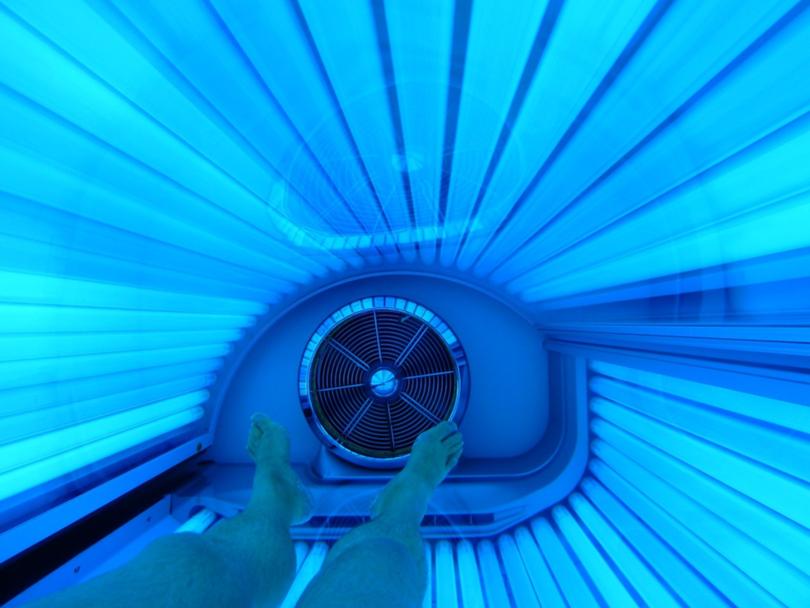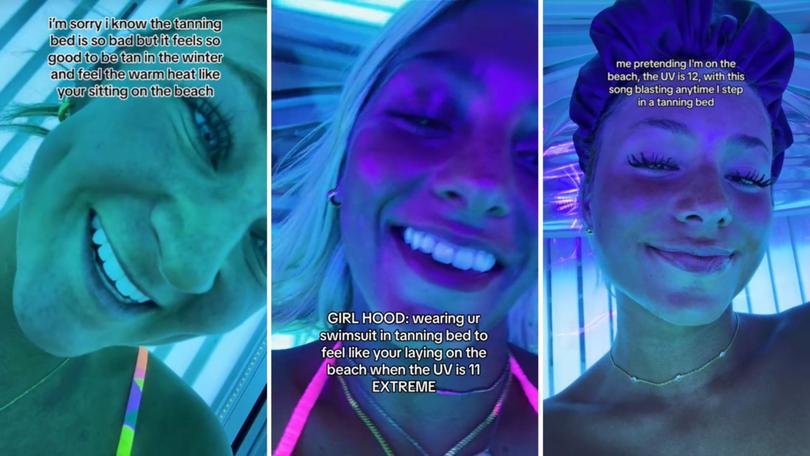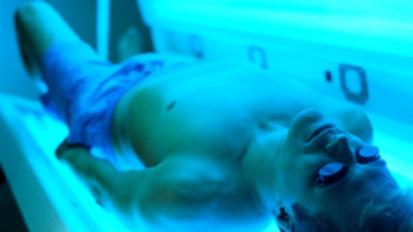Why so many young women are risking their lives for a sunbed tan? Thank TikTok influencers and reality TV

For the past five years, Gemma Hall, 24, has kept a controversial appointment two or three times almost every week. Although she says these sessions make her feel “calmer” when stressed and boost her confidence, her parents, for a start, are concerned.
Gemma is one of the surprising new generation of sunbed devotees. A bright and articulate criminology graduate, she is well aware she is risking skin cancer, but ploughs on regardless.
Such is her desire for the perma-tanned look popularised by the likes of Love Island stars — not to mention influencers paid by tanning brands to plug their products.
Sign up to The Nightly's newsletters.
Get the first look at the digital newspaper, curated daily stories and breaking headlines delivered to your inbox.
By continuing you agree to our Terms and Privacy Policy.“I feel more confident with a tan and my clothes look nicer,” Gemma, a careers adviser from Manchester, said.
“My friends use them too so it doesn’t feel like a big deal.
“And I like the fact that a tan from a sunbed lasts longer than fake tan, is obviously natural and I can see the results almost straight away rather than having to wait for it to develop over several hours.”

As for the substantial risk of skin cancer — sunbed exposure before the age of 35 has been proven to increase the risk of malignant melanoma by as much as 75 per cent — she is aware but undeterred.
“I’m well aware of the risks,” she said. “But I’d never go on for more than five or six minutes at a time, two or three times a week.
“My view is that everything should be done in moderation, whether that’s partying and drinking alcohol or going on sunbeds.”
However, experts are clear there is no such thing as safe sunbed use, due to the dangers of UV light.
One study, by the University of Minnesota, of women diagnosed with melanoma before the age of 30, found that 97 per cent of them had used sunbeds.
In 2010, the scientific evidence against sunbeds was thought to be so compelling, that the government banned under-18s from using them and by 2013 the number of tanning shops — once prolific on the High Street — had fallen by almost a third.
However, alarming new data suggests sunbeds are enjoying a renaissance among Generation Z, those born between the late-1990s and 2012. According to recent research by the charity Melanoma Focus, a shocking 42 per cent of young Brits aged 18 to 25 have used them.
Google revealed that searches for sunbeds have increased by 260 per cent in the past six months while “How many sunbed sessions do I need to get a tan?” is up 180 per cent.
Compare this to the decline in smoking since the dangers became known: 13 per cent of those over 18 smoked cigarettes in 2021, the lowest level since records began ten years earlier.
So why is sunbed use on the rise again?
Dr Paul Banwell, founder of The Melanoma and Skin Cancer Unit (MASCU) in East Grinstead, one of the largest skin cancer units in the UK, points to the pernicious influence of social media videos encouraging the younger generation to ignore medical advice.
“There are various influencing factors, including the millions of views on social media for the deadly beauty trend,” he said.
“Generation Z’s current use of sunbeds is a ticking time bomb that will lead to more cases of skin cancer in future. It is estimated that, across the country, sunbeds cause about 440 melanomas and around 100 deaths each year.”
TikTok’s community safety guidelines state that “marketing tobacco products, drugs, or other regulated substances” is banned because the platform recognises “that there are risks connected to trading and using these substances”.
Although sunbed use is also regulated, being banned for under-18s, these videos are not required to carry health warnings.
The hashtag #sunbed has more than 588 million views. And young women, some with hundreds of thousands of followers, upload footage inviting viewers to “come for a sunbed with me”.
Companies flogging tanning merchandise, and tanning salons themselves, use TikTok accounts to lure the platform’s young audience. Some are keen to highlight the supposed benefits of the most up-to-date sunbeds.
One tanning company with salons across the country claims the benefits of its Hybrid sunbed (hybrid because it uses a combination of both red light and UV) include reducing acne, increasing confidence and raising levels of the mood-boosing brain chemical serotonin.
But Dr Banwell says these claims are “not true”.
“There are a lot of misunderstandings about sunbeds, such as that they can give you a protective base tan to stop you burning in the sun. This is not true. Sunbeds bring on premature ageing, wrinkling of the skin, eye problems, and a high risk of skin cancer,” he said.
“Some will claim that using sunbeds helps with certain skin conditions such as acne and psoriasis. While UV exposure in moderation can sometimes help acne calm down, sunbeds may actually exacerbate acne scars as the UV rays have the potential to harm vital collagen and elastin fibres in the skin.”
Regarding the concept of “safer” hybrid tans Dr Banwell is clear: “There is no such thing as a safe tan or a safe sunbed.”
I think the marketing around any sunbeds in the UK — traditional or hybrid — is designed to make them feel ‘safer’ than they actually are. Sunbeds are just a no-no.
Another worrying trend in videos by TikTok creators is the use of tan accelerator sprays, which young women spray up their noses before having their sunbeds.
The sprays contain an artificial hormone called melanotan-2 which stimulates the skin cells that produce pigment, supposedly increasing the rate at which you tan. It is not illegal to use these sprays, but it is illegal to sell them in the UK due to serious health concerns.
Other young women can be seen rubbing an-accelerating body els, which are legal to sell and use, onto their skin to intensify the effect of the UV rays emitted by the sunbed. Some videos by businesses selling these products for use in sunbeds have racked up more than a million views on TikTok.
Dr Banwell advises people to steer well clear of all forms of tan accelerators: “It has been shown that long-term use of tan accelerators increases the risk of skin cancer. Tanning is a sign of sun damage, full stop.”
Yet that doesn’t deter British TikTok influencers — many of whom are still teenagers themselves — from promoting these products to their young following
One such influencer, aged 19 and with 400,000 followers, regularly shares videos of herself using sunbeds and offers followers discount codes for tanning products. In one video, she says she aims to use a sunbed two to three times a week.

Meanwhile, Gemma said there are other benefits to sunbeds: “I discovered I felt calmer and more relaxed after using a sunbed if I was stressed or tired. A combination of the warmth and time alone really de-stresses me, it’s a few minutes of escapism at the end of a busy day.”
Gemma was only 10 when she first used a sunbed and now pays £35 for a 30-minute course, which she breaks down into two or three sessions a week.
Again, content produced by TikTok users often refers to sunbeds as a form of “therapy”. Seemingly, tanning is being pushed on self-care-obsessed Gen Z as a twisted form of wellness.
However, Gemma’s parents, both in their 50s, have voiced concerns. And they are speaking from experience. Long before they were fully aware of the risks, they used to rent a sunbed from a tanning salon in the 1990s for home use. Gemma admits they now have the “sun damage and wrinkles” to prove it.
“I do worry more about my heightened risk of skin cancer than wrinkles because there’s plenty that can be done about skin ageing now such as Botox,” she said.
“Recently a sunbed-using acquaintance developed melanoma. I now regularly check my moles and try to limit my sunbed use. But I still believe everything is OK in moderation.”
Fellow sunbed fan Katie Field, 23, who works in fashion and consumer PR, has been having eight-minute sunbed appointments once or twice a week for the past year, even though she harbours concerns about the cancer risk.
“It was a particularly bad eczema flare-up on my arms and around my eyes which didn’t respond well to medication, that prompted me to start using them,” Katie said.
“I’d read online articles, forums and on social media about other eczema sufferers getting relief from using sunbeds, and my mum also suggested that occasional use might help.”
Katie said having a tan makes her feel more confident, too, and if she misses a session she “definitely feels less confident”, because it helps improve her skin condition.
“I live a fairly healthy lifestyle, don’t smoke and never drink to excess,” she said.
“I always wear SPF 30 on my body on holiday and SPF50 on my face year-round, including on a sunbed to help protect against pigmentation and wrinkles.”
Despite this SPF vigilance, she is willing to have regular sunbeds
“Yes I worry about the risk I’m exposing myself to,” she said.
“I know a few people Mum’s age and two my age who’ve had skin cancer scares and moles removed. I’ve already decided that I’ll slowly stop using sunbeds as I get older; when I’ll hopefully start to become more confident in my own skin instead of relying on a bit of a tan to feel good.”
She may want to call a halt sooner rather than later.

Dr Banwell explained that a team from the University of Manchester had been working with scientists in Australia — where the commercial use of UV beds was banned in 2015 — to look at the harm and costs linked with indoor tanning.
“The research in the British Journal of Dermatology suggests there could be 1200 fewer cases of melanoma, and 200 fewer deaths in the lifetimes of 18-year-old users if a similar ban was employed here,” he said.
Social media and brand executive Heather Hill*, 22, from London, uses a sunbed once a month — or more before a holiday. It was her mother who suggested she try sunbeds almost two years ago when she was “rundown while writing my university dissertation.
“She thought it might help to perk me up and relax me, as she always goes on a sunbed herself a couple of times before a holiday,” Heather said.
These days, she buys a package of 100 minutes for £80 ($A151) at a tanning shop on her route home from work and uses sunbeds once a month for 10 to 12 minutes.
“I increase that to twice a week for the week or two before a holiday. I’m quite fair-skinned so burn easily and get prickly heat but I find that using a sunbed provides me with a bit of a base tan that stops this,” she said.
“I used to apply fake tan religiously but having a natural tan is lower maintenance. Feeling pale restricts what I can wear. I feel slimmer and my cellulite is less obvious when I’m tanned, and I also wear less make-up — I feel more confident with a natural look. It’s definitely a psychological thing.”
Still, Heather concedes that she is aware of the dangers.
“I have an out-of-sight, out-of-mind approach to the risks of using sunbeds, which is probably very naive of me. But I feel using one for ten minutes at a time now and again to prevent burning on holiday is the lesser of two evils,” she said, adding that she “always” uses SPF 50 daily, “including before I use a sunbed”.
While her mother may have sparked Heather’s sunbed use, she is keen to emphasise that her daughter mustn’t overdo it, while her dad isn’t keen on her using them at all.
But she reasons: “They both sunbathe on holiday and Mum also uses a sunbed as a one-off for six minutes the week before going away.”
“There’s a perception that being tanned looks healthier. Before I started using fake tan and then sunbeds, people would ask me if I was unwell just because I was pale,” she added.
The irony, of course, is that her sunbed habit could leave her tanned — but seriously unwell.
*Names have been changed.
Additional reporting by Antonia Lenon.
